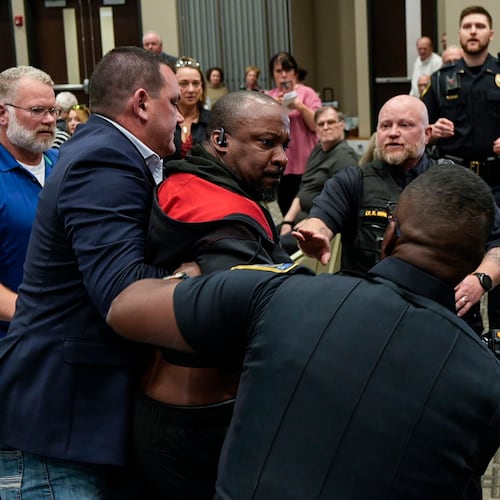WARRENTON — John Graham watched as the lack of reliable internet access made the coronavirus pandemic even tougher for families where he lives.
His Warren County neighbors couldn’t work from home, and students weren’t able to complete assignments. In a county that lacks a full-service hospital, telemedicine was difficult to implement.
When Graham, who chairs the Warren County Commission, learned that $350 billion in coronavirus relief funding was being spread across every city and county in America, he knew he wanted to invest in broadband.
The county formed a consortium that includes its three cities, neighboring McDuffie County and local school systems. They pooled their COVID-19 dollars, partnered with Comcast and have applied for state matching funds to increase their buying power.
Warren County, with a population of about 5,800, is among Georgia’s smallest, and it is in line to receive about $1 million. That figure represents about one-quarter of the county’s annual operating budget.
Overall, Georgia’s cities and counties are sharing $3.6 billion, not including dollars that went to the state, its agencies and school systems. All the money is part of the $1.9 trillion American Rescue Plan Act that President Joe Biden signed into law in March.
For small and rural municipalities, the money packs an even greater punch. They’ve never seen this level of federal funding before, nor the wide freedoms on how to spend it.
Election officials and staffers said they are taking time to pick the right projects and ensure the money is spent wisely.
Towns County in northwest Georgia, population 12,500, is in line for $2.3 million. Commissioner Cliff Bradshaw said some of the money was used for bonuses for city employees who worked through the pandemic. However, much of the first allocation is sitting in the bank while he confers with the county’s lawyer on the best way to spend it.
“Everything is on the table right now,” he said. “But that is part of the reason I’m working with the attorney on, ‘Can we do this?’ and, ‘Can we do that?’ ”
The National League of Cities’ Michael Gleason said the money going to the nation’s 3,143 counties and 19,000 cities is “unprecedented.”
“We really can’t underscore how important it is for some of these cities and towns to get this financial help, especially at a time when government employment was decreasing due to the pandemic,” he said. “This allows them to not only make up lost revenue but build their communities back in a stronger and more resilient way.”
Acceptable uses of the local funding include premium pay for essential workers, public health initiatives, programs addressing the negative economic impacts of the pandemic, replacing lost revenue, and investing in water, sewer and broadband.
Organizations such as the National League of Cities, the National Association of Counties, the Georgia Municipal Association and the Association County Commissioners of Georgia are providing training and guidance to help local governments navigate the process, including required reporting. So is the state’s Office of Planning and Budget.
Smaller cities and towns aren’t used to dealing with the federal government, and many don’t have the staffing to do so without outside assistance.
The city of Claxton, about an hour west of Savannah, has more experience with the feds than most of its size because it operates an airport and natural gas company. With a population of about 3,000 people, the “Fruitcake Capital of the World” is slated to receive $800,000.
Claxton Mayor Terry Branch says there are projects already underway to improve the water and sewer systems in the town established in the late 1800s. The city has approved $74,000 to replace pumps critical to the water system. An additional $25,000 is being used to repair streets where draining issues have eroded the pavement.
“A lot of communities that are our age, pipes just deteriorated through the years, and so that’s going to be a big focus of what we’re going to be doing this year with the money,” Branch said.
The Georgia Municipal Association has encouraged the state’s 537 cities to consider projects that, once paid for, are self-sustaining because the money is nonrecurring. Larry Hanson, the GMA’s executive director, has also stressed public input.
“We have encouraged our cities to plan, to go out and listen to their community and conduct assessments and make sure they’re spending it wisely,” he said. “We’ve encouraged them to be wise and be cautious.”
Louisville, located southwest of Augusta, served as Georgia’s capital from 1796 until 1807. But today it is a town of about 2,600 with aging residents often living in deteriorating homes.
Mayor Jenny Smith is using a portion of the city’s $825,000 in COVID-19 funding to renovate some of those houses. The city recently solicited applications and approved 19 residents for its program.
“We hired a home inspection company who went out and inspected every home inside and outside and documented all the deficiencies,” Smith said.
By the time the inspection reports came back, two of the applicants had died. Of the remaining homes, nine needed new roofs. Others required electrical or plumbing repairs. The costs far surpass the $125,000 that has been allocated for the program, but Smith is hoping the City Council approves more.
“We call it Building Up Louisville,” she said, “because we feel like we’re building up that particular home, we’re helping that homeowner and we’re also building up the city.”
About the Author
Keep Reading
The Latest
Featured



